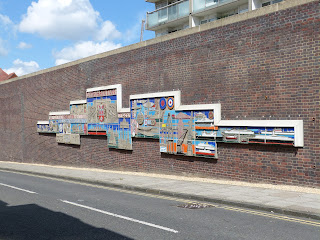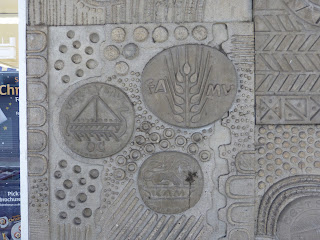Colchester
Installed 1969
Original location: Sainsbury's, Priory Walk
Current location: As original
Details in post of 13 April 2020
[Photograph taken 7 October 2019]
Gloucester
Installed 1970
Original location: Sainsbury's, Hare Lane
Current location: As original.
Details in post of 19 May 2019
[Photograph taken 27 March 2019]
Hitchin
Installed 1973
Original location: Sainsbury's, Brand Street
Current location: Hitchin Library (re-located 2003)
Details in post of 9 June 2019
[Photograph taken 19 April 2019]
Colchester
Installed 1974
Original location: Various subways under Southway
Current location: As original
Details in post of 11 April 2020
[Photograph taken 7 October 2019]
Newcastle
Installed 1974
Original location: BHS, Northumberland Street
Current location: As original (although shop is now Primark)
Details in post of 30 September 2019
[Photograph taken 16 September 2019]
Cwmbran
Installed 1974
Original location: Gwent House, Gwent Square
Current location: As original
Details in post of 14 August 2019
[Photograph taken 16 July 2019]
Colchester
Installed 1976
Original location; BHS, Lion Walk
Current location: Near Firstsite (re-located 2011)
Details in post of 20 October 2019
[Photograph taken 7 October 2019]
Bexhill
Installed 1976
Original location: Sainbury's, Buckhurst Place
Current location: As original
Details in post of 6 July 2019
[Photograph taken 18 May 2019]
Droitwich Spa
Installed 1976
Original loaction: Sainsbury's, St Andrew's Square shopping centre
Current location: As original (although shop now Wilkinsons)
Details in post of 3 August 2019
[Photograph taken 15 July 2019]
Worcester
Installed 1976
Original location: Sainsbury's, Windermere Drive
Current location: As original?
Details in post of 29 July 2019
[Photograph taken 14 July 2019]
Oxford
Installed 1977
Original location: Sainsbury's , Cowley Centre
Current location: As original (although shopping centre renamed as Templars Square, and shop now Wilkos)
Details in post of 13 June 2019
[Photograph taken 4 May 2019]
Southampton
Installed 1978
Original location: Sainsbury's , Lordshill
Current location: Hamtun Sreet (re-installed 2011)
Details in post of 20 July 2019
[Photograph taken 25 May 2019]
Stockport
Installed 1978
Original location: BHS, Merseyway Shopping Centre
Current location: As original (although shop now Poundland)
Details in post of 5 May 2019
[Photograph taken 15 March 2019]
Surbiton
Installed 1980
Original location: Sainsbury's, Victoria Road
Current location: As original
Details in post of 27 May 2019
[Photograph taken 6 April 2019]
Gloucester
Installed ?
Original location: BHS, Eastgate Street
Current location: As original (although BHS store now closed)
Details in post of 7 May 2019
[Photograph taken 27 March 2019]
Elmstead
Installed 1972
Original location: Elmstead School, Colchester
Current location: ?
No photographs or further details available.






























































































